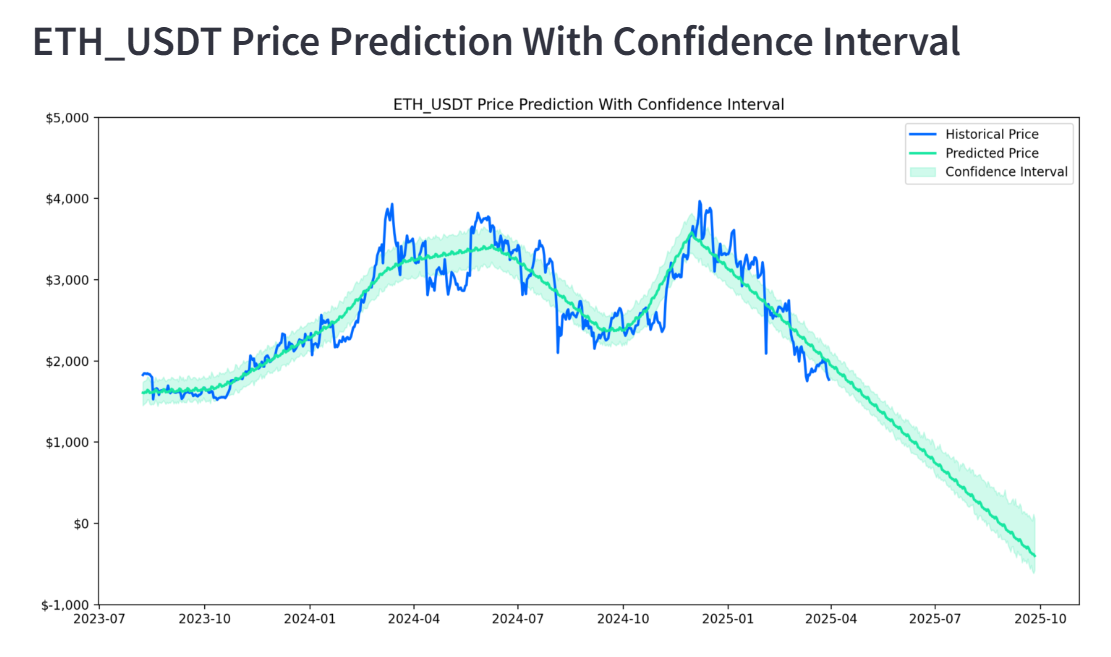¿Otro Cisne Negro en Cripto? Un Análisis Completo del Desplome de Ethereum
Tendencias recientes de precios de Ethereum
A partir del 29 de marzo, Ethereum cerró en $1,842, lo que marcó un descenso mensual del 13.12% pero no logró sostener el impulso al alza, debilitándose rápidamente.
Desde mediados de marzo, a pesar de varios intentos de rebote, ETH encontró una fuerte resistencia en el rango de $2,000-$2,100, reflejando un débil sentimiento alcista. Después del 22 de marzo, el precio de ETH rompió consecutivamente niveles de soporte clave, retrocediendo finalmente a su rango bajo actual.

Movimiento del precio de ETH del 1 de marzo al 29 de marzo (Fuente del gráfico: https://coinmarketcap.com/currencies/ethereum/)
Los indicadores técnicos revelan señales preocupantes, incluyendo un volumen de operaciones de 24 horas que disminuye un 25% semana tras semana, llegando a aproximadamente $1.19 mil millones de USD, una capitalización de mercado que se contrae a $222.3 mil millones de USD, y la acción del precio mostrando características de un desglose desde la consolidación hacia un patrón de continuación bajista.
La perspectiva inmediata sugiere posibles pruebas de la zona de soporte de $1,700-$1,800 USD a menos que ETH pueda recuperar $2,000 USD de manera convincente. Los participantes del mercado deben monitorear métricas de liquidez en cadena, clusters de liquidación de apalancamiento y posibles catalizadores positivos que podrían cambiar el sentimiento del mercado.
Por qué Ethereum está cayendo
Recientes hackeos de cuentas de Coinbase involucraron a atacantes que utilizaron ThorChain y Chainflip para mover activos robados de Bitcoin a Ethereum, convirtiéndolos en stablecoins para vender rápidamente. A través de Ethereum solamente, se descargaron 14,064 ETH (aproximadamente $27.5 millones de USD). El análisis sugiere que esto puede ser parte de una operación más grande realizada por el grupo de piratería de Corea del Norte, Lazarus, con pérdidas que superan los $46 millones de USD.

Movimientos de activos criptográficos del Grupo Lazarus (Fuente de la imagen:https://cn.cointelegraph.com/news/lazarus-group-deposits)
Por otro lado, datos recientes de la Oficina de Análisis Económico de EE. UU. revelaron un aumento del 2.8% interanual en el índice de precios del gasto en consumo personal básico de febrero. Esta lectura elevada de la inflación ha intensificado las preocupaciones sobre tasas de interés más altas sostenidas, creando vientos en contra adicionales para activos sensibles al riesgo en los mercados financieros.
En general, el sector de las criptomonedas enfrenta presiones compuestas tanto de las condiciones macroeconómicas como de las preocupaciones de seguridad. Este desafío dual ha desencadenado amplias caídas en el mercado, con la capitalización total del mercado de activos digitales retrocediendo de $3.3 billones en su punto máximo a aproximadamente $2.6 billones actualmente.
¿Hasta dónde puede caer Ethereum?
El gráfico revela que desde que alcanzó su pico cíclico a principios de 2025, ETH ha entrado en un canal bajista a medio plazo claramente definido. Los modelos predictivos actuales indican que el precio de referencia ha disminuido gradualmente desde sus máximos, y la tendencia a la baja se ha acelerado significativamente durante el segundo trimestre de 2025. El análisis técnico confirma además el debilitamiento de la dinámica del mercado, ya que los múltiples intentos de ruptura al alza de ETH en los últimos meses han fracasado, lo que refleja la disminución del impulso del capital y la erosión de la confianza de los inversores. La acción actual del precio se alinea precisamente con las proyecciones del modelo, lo que sugiere que el mercado está pasando por una fase integral de "reevaluación de precios" en respuesta a catalizadores negativos e incertidumbres macroeconómicas.
Mirando hacia adelante, se espera que el precio de ETH continúe su trayectoria descendente en los próximos meses. A menos que haya entradas de capital sistémicas, nuestros modelos proyectan que ETH podría disminuir hasta el rango de $1,000-$1,200 entre junio y septiembre de 2025, estableciendo potencialmente el rango inferior del ciclo. La banda de confianza más baja se extiende hacia aproximadamente $800, lo que indica una posible violación de los niveles de soporte psicológico bajo un sentimiento de mercado extremo o eventos cisne negro.
Notablemente, el intervalo de confianza mantiene elasticidad de volatilidad mensurable, lo que implica una estabilización potencial si mejora el sentimiento del mercado. Esta corrección parece más característica de un ajuste a mitad de ciclo dentro de un mercado alcista más amplio en lugar de un colapso estructural. Las variables clave que determinarán la acción futura del precio serán las condiciones macroeconómicas y el rendimiento fundamental en cadena durante el segundo y tercer trimestre de 2025.

Perspectivas del precio de Ethereum: Pronóstico de tendencias 2025 (Fuente de la imagen:Predicción de precios de Cripto · Streamlit)
Advertencia de riesgo de inversión
En el entorno actual del mercado, Ethereum enfrenta múltiples factores de riesgo superpuestos, y se recomienda a los inversores monitorear de cerca sus desarrollos. Desde una perspectiva de precio, ETH ha experimentado recientemente una volatilidad significativa, y la estabilidad del mercado aún no se ha establecido. Al mismo tiempo, las blockchains emergentes de alto rendimiento como Solana están atrayendo rápidamente usuarios y liquidez a través de activos meme y actividad de trading de alta frecuencia, lo que representa un desafío para la dominancia del mercado de Ethereum.
Recientemente, las grandes carteras en cadena (direcciones de ballenas) han mostrado ajustes de cartera y comportamiento adverso al riesgo en medio de la caída general del mercado de cripto. Algunos fondos están acelerando su retiro de contratos DeFi o de participación, lo que reduce aún más la confianza en el mercado. Más críticamente, las incertidumbres regulatorias en EE. UU. y otras economías importantes podrían imponer choques periódicos en la actividad comercial de ETH, la expansión de la plataforma y la estructura de liquidez.
Además, si bien el staking de Ethereum se ha convertido en un componente clave de su ecosistema on-chain, los inversores deben permanecer cautelosos acerca de las restricciones de liquidez y los riesgos de contratos inteligentes al participar en el staking, especialmente dada la volatilidad de precios en curso, que puede amplificar la exposición al riesgo. Se recomienda a los inversores evaluar la dinámica del mercado en línea con su tolerancia al riesgo, evitar el apalancamiento excesivo y monitorear las señales on-chain como referencia para las tendencias a medio y corto plazo.
Conclusión
En la actualidad, Ethereum está atravesando una fase crítica marcada por presiones macroeconómicas y riesgos de seguridad en la cadena. Aunque los indicadores técnicos a corto plazo aún no han señalado un claro cambio, los ciclos históricos y la actividad en la cadena sugieren que esta corrección puede representar una retirada a mitad del ciclo dentro de un mercado alcista en lugar de un colapso sistémico. El rendimiento futuro dependerá de la trayectoria de la inflación macroeconómica, los cambios en las políticas regulatorias y los avances tecnológicos y la escalabilidad de Ethereum en sí. Para los inversores, mantener un juicio racional, ejercer precaución en la posición y controlar el apalancamiento siguen siendo estrategias esenciales para capear los ciclos del mercado, especialmente en medio de una mayor volatilidad y riesgos de sentimiento no resueltos.
Artículos relacionados

Valor de los Blox Fruits: Cómo evaluar y maximizar el valor comercial de los Blox Fruits

Valor de Cripto PI: Lanzamiento en Mainnet el 20 de febrero de 2025 & Predicciones de precios futuros

¿Es XRP una Buena Inversión? Una Guía Integral sobre su Potencial

¿Cómo rastrear la transacción USDT BEP20?

Cómo vender Pi Coin: una guía para principiantes


